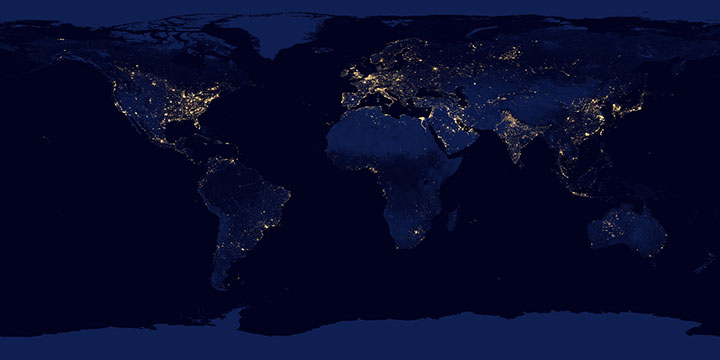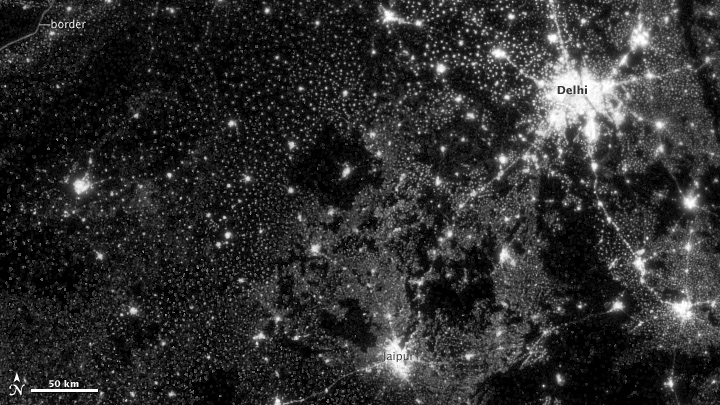

NPP Suomi and its VIIRS instrument pass over any given location on Earth at roughly 1:30 a.m. and 1:30 p.m. local time each day, observing the planet in vertical strips from pole to pole. VIIRS is a spectroradiometer, detecting photons of light in 22 different wavelength bands and collecting them in a similar fashion to the charge-coupled device in your digital camera.

Data for this map was acquired over 9 days in April 2012 and 13 days in October 2012. It took satellite 312 orbits and 2.5 terabytes of data to get a clear shot of every parcel of Earth’s land surface and islands. (Download Map Views - NASA Earth Observatory and NOAA National Geophysical Data Center)
Unlike a film camera that captures a photograph in one exposure, VIIRS produces an image by repeatedly scanning a scene and resolving it as millions of individual picture elements, or pixels. The day-night band goes a step further, determining on-the-fly whether to use its low, medium, or high-gain mode to ensure that each pixel accurately depicts the amount of light emitted.
“On a hand-held camera, there’s a nighttime setting where the shutter will stay open much longer than it would under daylight imaging conditions,” says Elvidge, who leads the Earth Observation Group at NOAA’s National Geophysical Data Center. “The day-night band is similar. It increases the exposure time — the amount of time that it’s collecting photons for pixels.” If a pixel is very bright, a low-gain mode on the sensor prevents the pixel from over-saturating. If the pixel is dark, the signal will be amplified.
Using this smart technology and improved optics, the VIIRS day-night band is ten to fifteen times better than the OLS system at resolving the relatively dim lights of human settlements and reflected moonlight. Each pixel shows roughly 742 meters (0.46 miles) across, compared to the 3-kilometer footprint (1.86 miles) of DMSP. Beyond the resolution, the sensor can detect dimmer light sources. And since the VIIRS measurements are fully calibrated, scientists now have the precision required to make quantitative measurements of clouds and other features.


Compared to the OLS system (top), the VIIRS day-night band (lower) is at least 10 times better at resolving the relatively dim lights of human settlements. Each VIIRS pixel is 742 meters (0.46 miles) across; OLS has a 3-kilometer footprint (1.86 miles). (View Large Image - NASA Earth Observatory and NOAA National Geophysical Data Center)
“In contrast to the Operational Line Scan system, the imagery from the new day-night band is almost like a nearsighted person putting on glasses for the first time and looking at the Earth anew,” Miller says. “VIIRS has allowed us to bring this coarse, blurry view of night lights into clearer focus. Now we can see things in such great detail and at such high precision that we’re really talking about a new kind of measurement.”

International Space Station astronauts captured this view of the American Midwest on January 31, 2012. Astronaut photography usually has better resolution but less consistency than the VIIRS satellite. (Watch the Video - ISS Crew Earth Observations)
Astronauts also take photographs of the Earth at night and, in fact, their images have even higher spatial resolution (typically 10s to 100s of meters per pixel). “But astronauts are not looking at Earth 24/7/365,” says William Straka, an atmospheric scientist at the University of Wisconsin. Due to the orbit of the International Space Station, Straka adds, they cannot see the surface in the extreme polar regions, though they can observe phenomena in the upper atmosphere. Also, the ISS passes over a given point on Earth every two or three days and at variable times, while Suomi NPP flies over the same point twice a day at roughly the same time. Some scientists are interested in making joint observations between VIIRS and the ISS because of the complementary combinations of spatial resolution, timing, and quantitative accuracy.